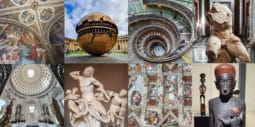

989381 travellers read
Nestled at the northern end of Rome’s Piazza Navona, the Fountain of Neptune (Fontana del Nettuno) stands as a testament to the city’s rich tapestry of art, history, and urban evolution. Beyond its aesthetic allure, this fountain encapsulates centuries of Roman ingenuity, from Renaissance architectural endeavours to 19th-century sculptural embellishments.
For historians, art enthusiasts, and holidaymakers alike, the fountain offers a captivating glimpse into Rome’s enduring legacy.
Contents
ToggleThe origins of the Fountain of Neptune date back to 1574, when Giacomo della Porta, a prominent architect of the late Renaissance, designed its basin under the patronage of Pope Gregory XIII. This initiative followed the restoration of the Aqua Virgo aqueduct, aiming to revitalise Rome’s water supply and public spaces.
Initially, the fountain featured a simple design, devoid of statues, serving primarily as a practical water source for the Campo Marzio district.
For over three centuries, the fountain remained unadorned, a stark contrast to its ornate counterparts in the piazza. However, the unification of Italy and Rome’s designation as the capital in 1870 spurred a renewed interest in enhancing public monuments. In 1873, a competition was held to enrich the fountain’s visual appeal, culminating in the addition of intricate sculptures by 1878.
The 19th-century sculptures by Antonio della Bitta and Gregorio Zappalà form a compelling visual narrative, capturing classical mythological themes through dynamic composition and expressive detail.
Antonio della Bitta’s powerful sculpture of Neptune, approximately 4 metres (13 feet) tall, depicts the sea god locked in fierce combat with a giant octopus.
Inspired by Baroque models such as Bernini’s dramatic compositions, Neptune’s muscular body twists vigorously as he wields his metal trident. The detailed octopus symbolises chaos subdued by divine authority, highlighting Neptune’s commanding role in classical mythology and artistic tradition.
This whimsical marble carving features a cherub comfortably seated atop a hybrid sea beast—part lion, part fish.
The creature’s fierce expression and dynamic stance contrast charmingly with the cherub’s peaceful demeanour, symbolising humanity’s harmonious coexistence with nature’s mysterious forces. The playful combination illustrates the sculptors’ creative blending of mythological symbolism with imaginative storytelling.
Gregorio Zappalà’s graceful Nereid gently restrains a swan using her elegantly coiled fishtail.
This unique composition merges mythical beauty with symbolic control, highlighting the sculptor’s skill in rendering varied textures—from the Nereid’s smooth skin to the swan’s delicate plumage. It subtly allegorises beauty’s relationship with nature’s untamed elements.
In sharp contrast, another Nereid engages in combat with a fierce sea dragon.
Her calm yet resolute expression amidst struggle symbolises humanity’s power to command even the wildest aspects of nature. The creature’s vivid, serpentine form complements the Nereid’s poised strength, illustrating artistic mastery of tension and movement.
This dynamic sculpture depicts a youthful cherub confidently restraining a powerful, agitated sea horse.
The expressive drama of the horse, rearing with flaring nostrils and flowing mane, contrasts vividly with the serene cherub. Symbolically, it conveys human control over nature’s unpredictable strength, encapsulating a central theme in classical and Baroque sculpture.
Zappalà’s Triton vigorously blows two conch shells, dynamically streaming water into the basin.
This figure blends anatomical precision with mythological symbolism, emphasising Triton’s dual nature—part man, part marine creature. The dramatic pose and powerful musculature echo Baroque energy, underscoring Triton’s role as the ocean’s herald. The figure unites mythological symbolism with refined academic sculptural techniques.
The Fountain of Neptune serves as more than a decorative element; it represents Rome’s evolving identity and artistic aspirations.
Its transformation from a functional water source to a sculptural masterpiece mirrors the city’s broader shift towards celebrating its historical and cultural heritage. The fountain’s completion in the late 19th century also reflects the era’s emphasis on national unity and pride, aligning with Rome’s status as the capital of a unified Italy.
Moreover, the fountain complements the other two prominent fountains in Piazza Navona—the Fountain of the Four Rivers and the Fountain of the Moor—creating a cohesive narrative that spans different artistic periods and styles. Together, they transform the piazza into an open-air museum, showcasing Rome’s rich artistic lineage.
Today, the Fountain of Neptune remains a focal point for visitors to Piazza Navona. Its intricate sculptures and historical significance offer a multifaceted experience for tourists, scholars, and art enthusiasts. Whether one is drawn to its artistic details or its place within Rome’s urban development, the fountain stands as a compelling symbol of the city’s enduring allure.
Author: Artur Jakucewicz
This website uses cookies. For more info read the cookies policy
RomeItaly.guide © 2025. Created with love by Roman experts and guides.